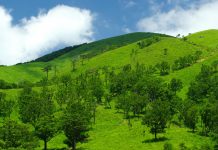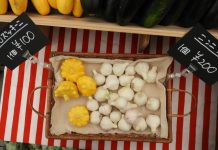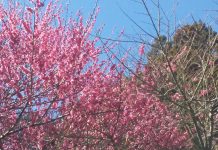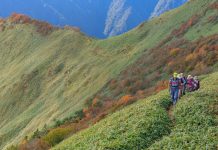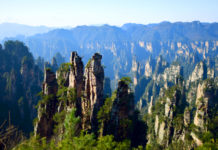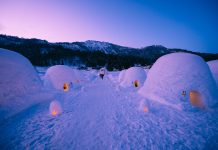The practice of hanami is centuries old, starting during the Nara Period (710-784) and is said to have been influenced by the Chinese Tang Dynasty’s custom of enjoying flowers.
Although, it was ume blossoms that people admired most at that time, by the Heian Period (794-1192), sakura was attracting more attention. From then on, in tanka and haiku poems, “flowers” equated to “sakura.”
Hanami was first used as a term analogous to cherry blossom viewing in the Heian era novel Tale of Genji. From this point the “hanami” and “flower party” became synonymous with cherry blossom viewing. Emperor Saga of the Heian Period continued the custom and held hanami feasts with sake underneath the blossoming boughs of sakura trees in the Imperial Court in Kyoto.
Poems would be written praising the delicate flowers, which were seen as a metaphor for life itself, luminous and beautiful yet fleeting and ephemeral. This “temporary” view of life is much discussed in Japanese culture and is often viewed as an admirable form of existence—as in the ancient samurai’s noble view of life ending at the height of one’s beauty. This symbolism still provides a popular subject for art, literature and dance.
Hanami parties blossomed in popularity during the Azuchi-momoyama Period (1568-1600) with the most elaborate of the parties held by Toyotomi Hideyoshi in Yoshino and Daigo. These parties are depicted on famous folding screens that show scenes from the festivities. The custom was limited to the elite of the Imperial Court but it soon spread to samurai society.
Shortly after that farmers began their own custom of climbing nearby mountains in the springtime and having lunch under the blooming cherry trees. This practice, then known as the “spring mountain trip,” became fused with that of the nobles’ to form the urban culture of hanami. By the Edo Period (1600-1867) commoners began to partake in the festivities, partly as a result of Tokugawa Yoshimune planting cherry blossom trees in public areas to encourage the custom.
The tradition continues today, with people gathering in great numbers under the, literally thousands of, ideal spots throughout Japan and usually partying on until late at night. Because of its long history, hanami is deeply rooted in Japanese society encompassing people of all walks of life.
This aspect of Japanese culture, the appreciation of nature up close, is the product of Japan’s natural environment, its four distinct seasons, and the sensibilities of its people. In over half of Japan, the hanami season coincides with the beginning of the scholastic and fiscal years, therefore school and company welcoming parties are often opened with hanami. Many company freshmen are often sent out early in the morning to hold that perfect place for a party later in the day. Now it’s your turn to get out there and do your part to keep the tradition going strong.
To find the latest Cherry Blossom Forecast Calendar visit the JNTO Forecast Calendar for the current calendar year. Link: 2021 Cherry Blossom Calendar for Japan



